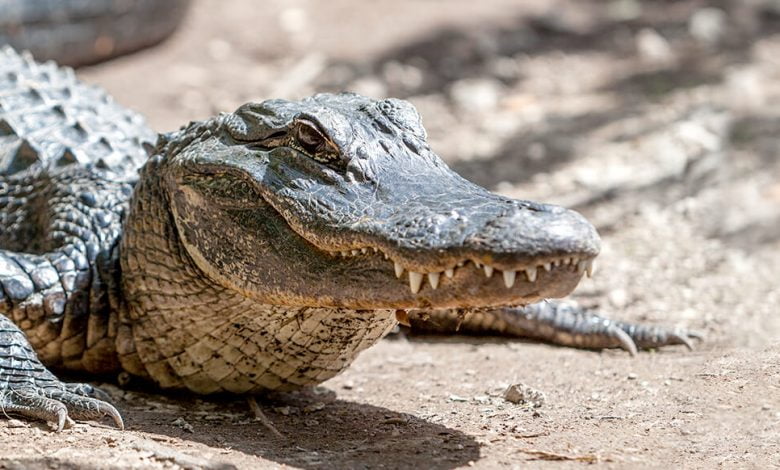Differences from crocodiles

While there are rules of thumb for distinguishing alligators from crocodiles, all of them admit exceptions. Such general rules include:
Exposed vs. interdigitated teeth: The easiest way to distinguish crocodiles from alligators is by looking at their jaw line. The teeth on the lower jaw of an alligator fit into sockets in the upper jaw, leaving only the upper teeth visible when the mouth is closed. The teeth on the lower jaw of a crocodile fit into grooves on the outside of the top jaw, making both the upper and lower teeth visible when the mouth is closed, thus creating a “toothy grin.”[45]
Shape of the nose and jaw:
Alligators have wider, shovel-like, U-shaped snouts, while crocodile snouts are typically more pointed or V-shaped. The alligators’ broader snouts have been contentiously thought to allow their jaws to withstand the stress of cracking open the shells of turtles and other hard-shelled animals that are widespread in their environments.[45][46] A 2012 study found very little correlation between bite force and snout shape amongst 23 tested crocodilian species.[47]
Functioning salt glands:
Crocodilians have modified salivary glands called salt glands on their tongues, but while these organs still excrete salt in crocodiles and gharials, those in most alligators and caimans have lost this ability, or excrete it in only extremely small quantities.[45] The ability to excrete excess salt allows crocodiles to better tolerate life in saline water and migrating through it.[45] Because alligators and caimans have lost this ability, they are largely restricted to freshwater habitats, although larger alligators do sometimes live in tidal mangroves and in very rare cases in coastal areas.[45]
Integumentary sense organs: Both crocodiles and alligators have small, pit-like sensory organs called integumentary sense organs (ISOs) or dermal pressure receptors (DPRs) surrounding their upper and lower jaws.[45] These organs allow crocodilians to detect minor pressure changes in surrounding water, and assist them in locating and capturing prey. In crocodiles, however, such organs extend over nearly the entire body.[45] Crocodile ISOs may also assist in detection of local salinity, or serve other chemosensory functions.[45]
Less consistent differences: Crocodiles are generally thought of as more aggressive than alligators.[45] Only six of the 23 crocodilian species are considered dangerous to adult human beings, most notably the Nile crocodile and saltwater crocodile. Each year, hundreds of deadly attacks are attributed to the Nile crocodile in sub-Saharan Africa. The American crocodile is considered to be less aggressive. Only a few (unverified) cases of American crocodiles fatally attacking humans have been reported.[48] Alligators also tend to be larger than most crocodile species.[45] However, there are numerous exceptions to these rules.
